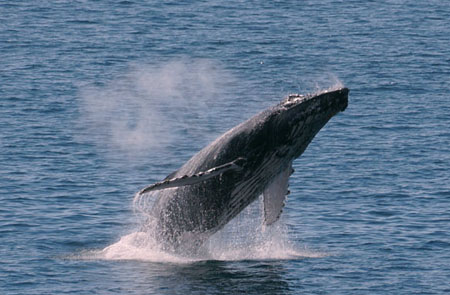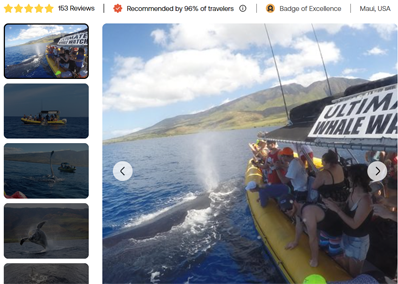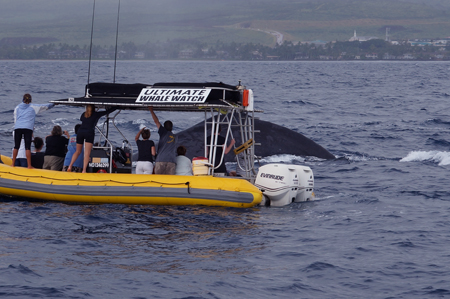Whale Season on Maui!

My Humpback Whale Connection
I moved to Maui in 1980 and was immediately captivated by the island's natural beauty, especially during whale season. Living in a North Kihei condo overlooking Maalaea Bay, I witness these majestic mammals up close everyday during whale season. My chance meeting with the late Greg Kaufman, founder of the Pacific Whale Foundation, sparked my passion for Humpbacks. We began tracking whales from my rooftop using binoculars, telescopes and spotting scopes, aided by a few dedicated volunteers. Little did we know this humble start would evolve into a global organization with over 200 employees, researching marine mammal behavior, combating threats and operating sustainable whale watching tours in Hawaii, Australia and Ecuador.
Are They Here Yet?
As the year winds down the anticipation builds and you start hearing that familiar question visitors ask "are they here yet"? Although the official whale season in Maui doesn’t start until December 15th, typically, humpback whales begin arriving on Maui's shores in late October, with peak season unfolding from mid-December to mid-May. The initial influx consists of adult males, followed by females and calves. As winter months warm, mating and calving intensify. By April, the whales start their 3,000-mile journey back to Alaska's feeding grounds, with most departing Maui's waters by mid-May. This predictable cycle makes Maui's among the best humpback whale destinations in the world.
The Top Maui Whale watches
Every year, from November to May, thousands of humpback whales migrate from Alaska to Maui's warm waters to breed and give birth. Witness these majestic creatures up close on a guided Maui whale watching tour. Expert guides share insights into whale behavior and biology as you observe playful breaching, interactions and mesmerizing underwater songs via hydrophone. Choose from catamaran or raft tours for an unforgettable encounter with these enigmatic marine mammals. Click to Review & Purchase.
Humpback Fact
Humpback whales are renowned for their incredible migratory journeys traveling over 3,000 miles from Alaska's icy waters to Hawaii's warm waters. This arduous migration, one of the longest of any mammal, is driven by the quest for food, shelter, mating, birthing, and nursing their young. One fascinating fact: they can travel up to 16,000 miles annually, making them one of the most traveled animals on the planet! Every year, they embark on an epic journey from summer feeding grounds in polar waters to winter breeding and calving grounds in warmer tropical waters, typically around Hawaii, the Caribbean or Australia. This impressive migration takes 6-8 weeks, driven by quests for food, shelter and suitable breeding habitats. During this journey, they navigate treacherous waters, avoiding predators and human-made obstacles. This extraordinary migration pattern underscores adaptability, resilience and innate ability to traverse vast distances, solidifying their place as awe-inspiring creatures in the ocean.
Top-Rated Maui Whale Watching Tours
Ultimate Whale Watch & Snorkel offers intimate, 2-4 hour rafting tours with expert crews. Sail Maui provides relaxing sailboat experiences from Ma'alaea Harbor, ideal for families. Maui Adventure Tours offers unique kayaking whale watching tours for an active experience. Kai Kanani, departing from Maluaka Beach in Wailea, features convenient beach loading and spacious sailboats. Redline Rafting, operating from Kihei Small Boat Harbor, offers affordable 1.5-hour tours with a maximum of 24 people. Choose from these top-rated options for an unforgettable whale watching experience on Maui. Considerable mentions: Consider guided tours with expert naturalists from Pacific Whale Foundation, Trilogy Tours, Maui Adventure Cruises or Hawaii Nautical. These tours offer personalized experiences, expert insights and a focus on education, conservation and responsible whale watching. Alternatively, opt for self-guided viewing at the Humpback Whale National Marine Sanctuary Visitor Center or scenic spots like Wailea Point, Papawai Point and McGregor Point. Remember to respect whales' space, support eco-friendly operators and plan your visit between December 15 and May 15, with peak season from January to March.
Humpback Whale Calves' Daily Diet
Newly born humpback whale calves consume approximately 50-60 gallons (190-227 liters) of nutrient-rich milk daily, produced by their mothers. This abundant milk supply, containing up to 50% fat, supports rapid growth and development. In fact, humpback calves gain around 90-100 pounds (41-45 kilograms) daily, reaching 1-2 tons by weaning age (6-12 months). This remarkable feeding habit ensures the calves' survival and prepares them for their future migrations and oceanic adventures.

Capturing Humpback Whales on Camera
I took this picture on whale day at McGregor's point on Maui. I shot all the pictures and videos (bottom of page). To capture breathtaking images of humpback whales, consider these expert tips. Timing is crucial – aim for early morning while trade winds are light or late afternoon when they subside and the golden light prevails. Position yourself with the sun at your back to minimize glare. If on a boat brace and balance yourself in a solid position enabling the free use of both arms. Anticipate breaching, tail slapping or spyhopping for dramatic captures. Use a telephoto lens (70-200mm or 100-400mm) for intimate, up-close shots. Shoot in burst mode to freeze dynamic moments. If kayaking or on a boat respect whales' space – maintain a safe distance to avoid disturbing them. Experiment with different angles, such as from a low or high vantage point, for unique perspectives.

Humpback Whale Mating Dance: A Majestic Spectacle
In Hawaii's oceanic arenas, humpback whales perform an intricate ballet, showcasing majestic maneuvers to secure mating rights. This captivating dance, often lasting hours, features breathtaking displays of agility and strength. Male humpbacks engage in intense competitions, breaching (leaping), lobtailing (slapping tails) and spyhopping (popping heads above water). Females assess suitors' prowess, selecting optimal partners for successful reproduction. Researchers note complex behaviors like "escalating rivalry" and "coordinated display," highlighting humpbacks' sophisticated social dynamics and communication. This awe-inspiring spectacle underscores the beauty and complexity of humpback whale courtship rituals.
Protecting Humpback Whales: Conservation Efforts
Humpback whales, once endangered, now thrive thanks to concerted conservation efforts. The Marine Mammal Protection Act (1972) and Endangered Species Act (1973) safeguarded their populations. International agreements, such as the International Whaling Commission's (IWC) global moratorium on commercial whaling (1986), further protected them. Organizations like the Pacific Whale Foundation, Ocean Conservancy and World Wildlife Fund promote research, education and habitat preservation. Responsible whale watching practices, reduced entanglement in fishing gear and mitigation of ocean noise pollution also support conservation. Continued efforts focus on addressing climate change, ship strikes and plastic pollution, ensuring the long-term survival of these majestic creatures and their habitats.
Whale Songs: The Haunting Melodies of Humpback Whales
In the depths of Hawaii's oceans, humpback whales serenade with ethereal songs, echoing majestic melodies that mesmerize and intrigue. These complex compositions, lasting up to 20 minutes, weave moans, groans and chirps into haunting harmonies. Scientists unravel the mystery behind these vocal masterpieces, revealing a primary mating strategy where male humpbacks showcase their vocal prowess to allure potential mates. Each whale's song is distinct, featuring unique themes, rhythms and cadences. Researchers identify repetitive patterns, dubbed "themes," reused and modified across different songs, offering glimpses into humpback behavior, social structures and communication patterns.
Predators of the Deep: Humpback Whales' Natural Enemies
In the vast oceanic expanse, humpback whales confront formidable foes. Orcas (killer whales), their primary predators, target weak or injured humpbacks, exploiting vulnerabilities. Sharks, particularly tiger and great white sharks, also prey on humpback calves or distressed adults. Additionally, human activities like entanglement in fishing gear, ship strikes and noise pollution pose significant threats. Climate change further disrupts humpback habitats and prey distribution, exacerbating vulnerabilities. These natural enemies and human-induced stressors underscore the complexities of humpback whale survival.
Allies in the Ocean: Humpback Whales' Natural Friends
Humpback whales find unlikely allies in their oceanic realm. Dolphins, specifically bottlenose dolphins, have been observed guiding lost or distressed humpbacks back to their pods. Sea lions and seals occasionally assist humpbacks by distracting or deterring predators. Even other whale species, like gray whales and minke whales, interact peacefully with humpbacks, demonstrating a complex web of marine relationships. Additionally, oceanic conditions like coral reefs and kelp forests provide vital habitats and refuge for humpbacks, highlighting the interconnectedness of marine ecosystems.
Humpback Whales: Facing Multifaceted Threats
Despite conservation progress, humpback whales confront escalating threats. Again, entanglement in fishing gear and marine debris injures or kills hundreds annually. Ship strikes, particularly in busy shipping lanes, pose significant risk. Noise pollution from human activities like seismic surveys, sonar testing and shipping disrupts communication and behavior. Climate change alters prey distribution, affecting nutrition and reproduction. Habitat degradation, offshore drilling and coastal development further jeopardize their survival. Additionally, plastic pollution, overfishing and disease transmission from human activities exacerbate these threats. The International Union for Conservation of Nature (IUCN) still lists humpback whales as vulnerable, emphasizing the need for sustained conservation efforts and responsible human practices to safeguard their future.
Humpback Whales in Hawaiian Culture
In Hawaiian culture, humpback whales hold deep spiritual significance, associated with gods Lono, Kanaloa and Aumakua, representing fertility, peace and ancestral guidance. Their migrations symbolize renewal, balance and connection between sea and land. Embodying ohana (family), aloha (love) and maluhia (peace), whales are revered and protected through ceremonies, prayers and storytelling. Hawaiians cherish their gentle nature, respecting habitats and passing down traditions to ensure the majestic creatures' well-being for future generations.
Conclusion
Hawaii's humpback whales are a cherished legacy, inspiring wonder and reverence. As we cherish their majesty, we must honor our stewardship role, protecting their habitat through conservation and sustainability. By doing so, we safeguard the enchantment of Hawaii's oceans, preserving an enduring treasure for generations to come, where these gentle giants continue to thrive, majestically gracing Hawaiian waters for generations to come..

For getting to these whale watching sites a rental car is a must! Hawaiicarrental.com is the right place to book.


